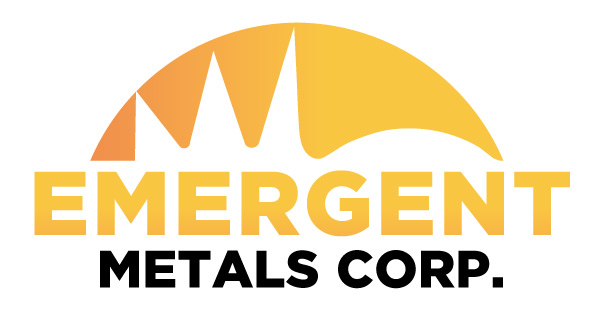PROPERTY OVERVIEW
| LOCATION | 11 km west of Val d’Or, Quebec |
| TYPE OF PROJECT | Early stage exploration |
| NUMBER OF CLAIMS | 7 |
| PROPERTY SIZE | 184 ha |
| OWNERSHIP | Property owned by O3 Mining (TSXV: OIII) |
| PROPERTY STATUS | Royalty Interest Only |
| UNDERLYING ROYALTIES |
|
|
EXPLORATION COMPLETED |
|
| KEY EXPLORATION TARGETS
|
East and West Zones found along Marbenite Deformation Corridor |
| NI 43-101 TECHNICAL REPORT |
NI 43-101 Technical Report Pertaining to the East-West Property, Val d’Or Area, Northwestern Quebec, Abitibi Region NTS 32C04, Prepared for Knick Exploration Inc. by Donald Theberge, P. Eng. M.B.A., November 21, 2017 |
| MINERAL RESOURCES | None defined to date |
|
EXPLORATION HIGHLIGHTS |
|
INTRODUCTION
On December 11, 2019, Emergent announced it had signed a Claim Purchase and Option Agreement giving the Company the option (the “First Option”) to acquire up to a 50% interest in the East-West Property (“East-West” or the “Property”) from a private individual. The remaining 50% interest in the Property was owned by Knick Exploration Inc. (“Knick”) (TSXV: KNX). Emergent agreed to pay:
- 4,000,000 common shares in the share capital of Emergent (the “Share Consideration”), issued to the Vendor on January 3, 2020, the Closing Date (issued);
- a cash payment of CAD$35,000 to be paid to the Vendor upon the three-month anniversary of the Closing Date (paid);
- a cash payment of CAD$50,000 to be paid to the Vendor upon the six-month anniversary of the Closing Date (paid); and
- a cash payment of CAD$50,000 to be paid to the Vendor upon the nine-month anniversary of the Closing Date (paid).
Emergent also acquired, as part of the transaction, a second option (the “Second Option”) to increase its ownership in the Property to 55%, which was never exercised. The transaction was approved by the Toronto Venture Exchange (the “Exchange”) on January 3, 2020.
On November 1, 2021, the Company announced it has completed the First Option and acquired a 50% interest in the Property.
On September 27, 2022, Emergent announced it had acquired the remaining 50% interest in the East-West Property and the Trecesson Property from Knick Exploration. The Transaction was completed as part of a Commercial Proposal made under the Canadian Bankruptcy and Insolvency Act by Knick with its creditors. The Proposal was agreed to by a vote of creditors and subsequently approved by the Superior Court of Quebec, Abitibi District. Emergent paid the Trustee C$160,000 in return for Knick’s interest in the properties. In addition, operations loans totaling C$110,000 advanced to Knick were considered as part of the acquisition cost of the East-West Property and Trecesson Properties by Emergent.
On May 3, 2022, Emergent announced it has completed the sale of its East-West Property, Quebec to O3 Mining Inc. (“O3”) (TSXV: OIII)(the “Transaction”) previously announced in a March 15, 2022, press release. As consideration for the acquisition of Emergent’s interest in the East West Property, O3:
- Paid to Emergent cash consideration of C$750,414.25 at closing;
- issued to Emergent an aggregate of 325,000 common shares in the capital of O3 (the “Share Consideration“) at closing; and
- iii.granted to Emergent a 1% net smelter returns (“NSR“) royalty over the East West Property in favor of Emergent (the “Royalty“), which shall be subject to a buy-back right in favor of O3 (the “Buy-Back Right“), whereby O3 may elect to buy back the Royalty for: (i) C$500,000 if the Buy-Back Right is exercised within the first three years from the date of the Definitive Agreement (as defined herein); (b) C$1,000,000 if the Buy-Back Right is exercised within the fourth and fifth years from the date of the Definitive Agreement.
For greater certainty, subsequent to the fifth anniversary date of the Definitive Agreement for the Transaction, the Royalty will no longer subject to the Buy-Back Right.
East-West, also known as the Little Long Lac Property, is located in Dubuisson Township, Quebec, near the town of Val-d’Or. The claim block totals 184 ha. It is located in the Val d’Or Mining Camp and is on strike, west of, and adjacent to Wesdome Gold Mines Ltd. (TSX: WDO) Kiena Complex which hosts the producing Kiena Mine. The Kiena Complex produced more than 2.8 million ounces of gold from 1981 to 2013 and re-started production in 2021. It is also on strike, east of, and adjacent to O3’s Marban Property which contains three past producing Mines (Marban, Norlartic, and Kierrans) that produced more than 590,000 ounces of gold. The Property appears to be situated on the Marbenite fault and deformation corridor and has similar mineralized structures that trend through the adjacent Kiena and Marban Mines.
The Property is an early to advanced stage exploration project. A NI 43-101 Technical Report was completed on the Property in 2017 by Knick and is available under that company’s corporate filings at www.sedar.com. Historic work on the Property, prior to 2007, includes more than 41,000 m in drilling in 180 drill holes. Knick acquired the Property in 2007 and subsequently conducted three drilling programs totaling 17,728 m of drilling in 100 drill holes.
The location of East-West in the vicinity to other exploration properties, past producing mines, or operating mines does not guarantee exploration success or that mineral resources will be defined on the East-West Property. There are currently no mineral resources or reserves yet defined on the Property that meet NI 43-101 or CIM Standards for Disclosure.
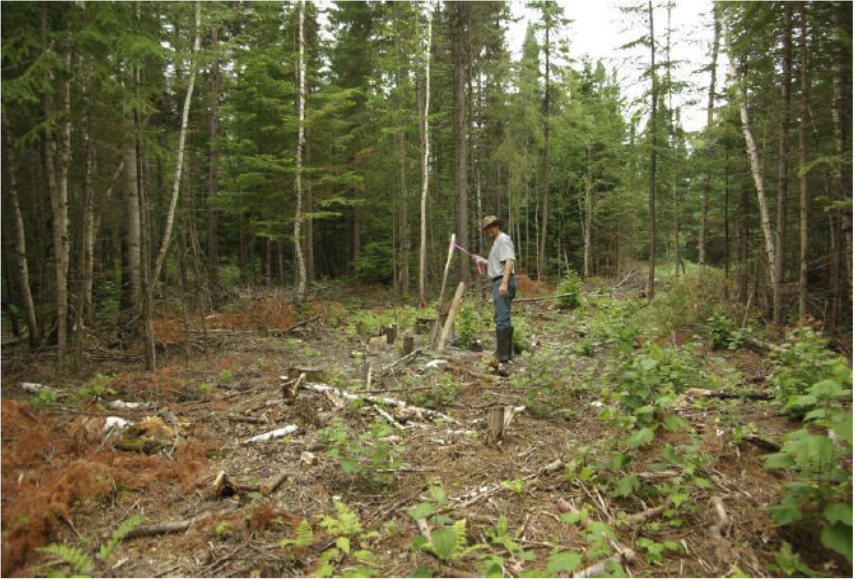
East-West Property – Drill Site
Source: 2017 Knick East-West Technical Report
LOCATION & OWNERSHIP
East-West lies on NTS5 sheet 32C04, in Dubuisson Township. The geographic center of the Property is located at UTM coordinates 279 263E/5 334 664N (Zone 18U NAD83), or approximately 11 km west of the town of Val d’Or. The Property consists of 7 mineral claims totaling 184 ha and is 100% owned by O3 Mining Inc.
Emergent retains a 1% NSR over the East West Property in favor of Emergent, which is subject to a buy-back right in favor of O3 (the “Buy-Back Right“), whereby O3 may elect to buy back the Royalty for: (i) C$500,000 if the Buy-Back Right is exercised within the first three years from the date of the Definitive Agreement (as defined herein); (b) C$1,000,000 if the Buy-Back Right is exercised within the fourth and fifth years from the date of the Definitive Agreement.
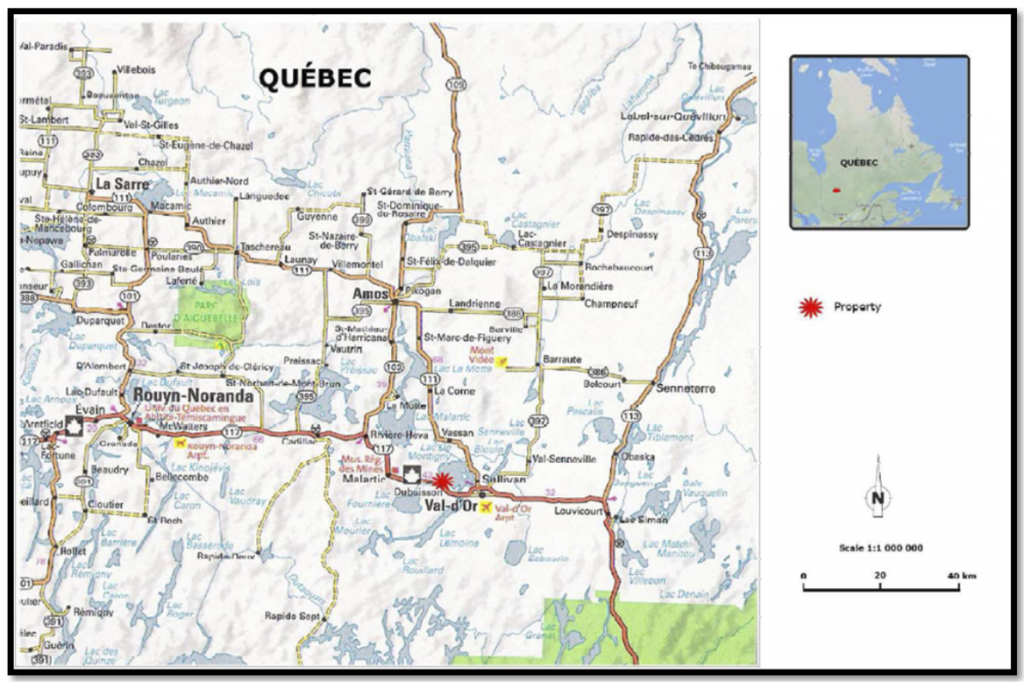
East-West Property – Location
Source: 2017 Knick East-West Technical Report
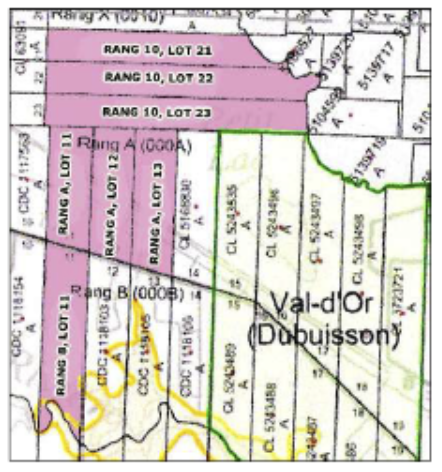
East-West Property Claims
Source: 2017 Knick East-West Technical Report
(no scale, north at top)
The Property also has two additional underlying royalties owned by others. A 1.75% NSR (Pratt Royalty) can be purchased at any time by the owners of the Property for C$1.5 million. A second 1.75% NSR (Mersereau Royalty) exists of which 0.5% can be purchased at any time by the owners of the Property for C$0.5 million
GEOLOGY & MINERALIZATION
The Property is on strike, west of, and adjacent to Wesdome’s Kiena Complex which hosts the past producing Kiena Mine. The Kiena Complex produced more than 2.8 million ounces of gold from 1981 to 2013 and has a permitted 2,000 tonne per day milling and refining complex currently on care and maintenance. On May 27, 2020, Wesdome announced by press release positive economic resulst from and Preliminary Economic Assessment (“PEA”) with the goal of restarting production at the Kiena Mine.
East-West is also on strike, east of, and adjacent to O3 Mining’s Marban Block Property which contains three past producing Mines (Marban, Norlartic, and Kierrans) that produced more than 590,000 ounces of gold. The Property is situated on the Marbenite fault and deformation corridor and has similar mineralized structures that trend through the adjacent Kiena and Marban Mines. Overall, the Property geology and mineralization is similar to those adjacent mines. One May 7, 2020, O3 Mining announced by press release they were commencing preparation of a Preliminary Economic Assessment (“PEA”) for the Marban Property with the goal of bringing the Marban Property into production.
Note that the location of the East-West Property adjacent to the Kienna or Marban Properties does not guarantee mineral resources or reserves will be delineated at East-West. There are currently no mineral resources or reserves that mean NI 43-101 or CIM Standards of Disclosure delineated on the East-West Property.
East is located in Archean-age rock formations that are part of the Abitibi greenstone belt, which lies within the Superior Province of the Canadian Shield. The Property is underlain from north to south by the Jacola and Val-d’Or formations and the Kewagama Group. Contacts between the lithological units are generally faulted and oriented NW-SE, with sub-vertical dips toward the south.
The Jacola Formation covers approximately the NE part of lots 21 to 23, range 10. It is made up of ultramafic flows (komatiites) and basalts. Ultramafic flows are Al2O3-poor, with an average of 5 to 7%, and magnesium-rich (+20% MgO). Basalts are of tholeiitic affinity. These structurally controlled rock formations strike NW-SE.
The Val-d’Or Formation is made up of mafic to intermediate volcanics. These usually form massive flows but can be locally pillowed or brecciated. They are similar to those of the Jacola Formation. These basalts and andesites are often sheared. They are stratified with units of mafic to intermediate tuffs and cut by many intrusives. The upper contact tested by drilling corresponds to an epiclastic sequence composed of lapillis and bedded tuffs of dacitic composition, interlayered with mafic units. The sequence has been tested by drilling over approximately 150 m.
The Kewagama Sedimentary Group underlies the southern part of the Property. These sediments are made up of an interlayering of siltstone and argillaceous schist. They are often aphanitic.
The Marbenite fault and deformation corridor occurs on the Property, and generally strikes northwest to southeast. It roughly parallels the stratigraphy as it is located close to the contact between the Jacola and Val-d’Or formations. Mineralization to date has, for the most part, been found in the vicinity of this fault. Two main zones of mineralization have been identified by drilling to date – the West Zone and the East Zone. Three other zones have also been identified but are at an earlier stage of exploration. The Marbenite Fault is inferred to cross the West Zone and is closely associated with the East Zone. The Marbenite Fault is also associated with the adjacent Marban and Kiena Mines, located to the NW and SE of the Property, respectively.
The typical drill section of the northern part of the Property cross a succession of high strain zones situated on contacts between massive mafic to intermediate units with komatiite flows of the Jacola Formation over a thickness of about 400 m. A higher deformation level exists that is associated with strong chlorite, chlorite-talc, chlorite-talctremolite, and talc carbonate alteration zones. Lamprophyre dyke swarms are commonly embedded in these structures and can also be used to identify faults and shear zones as parts of the Marbenite deformation system. The Jacola Formation has a prominent magnetic signature on the airborne total field map, mainly related to predominant komatiitic flows.
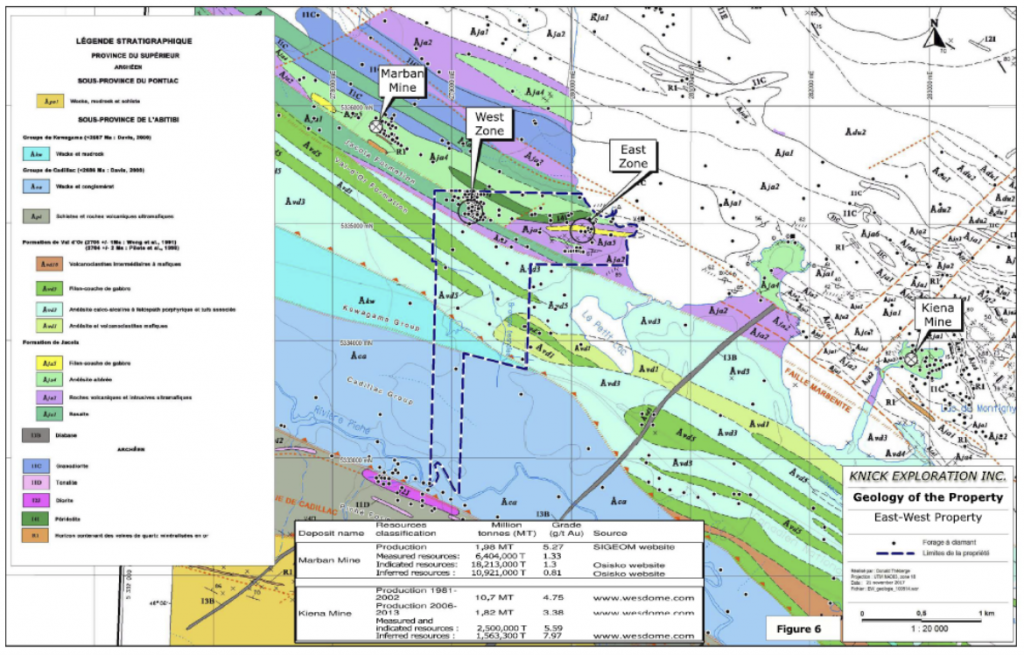
Geology of the East-West Property
Source: 2017 Knick East-West Technical Report
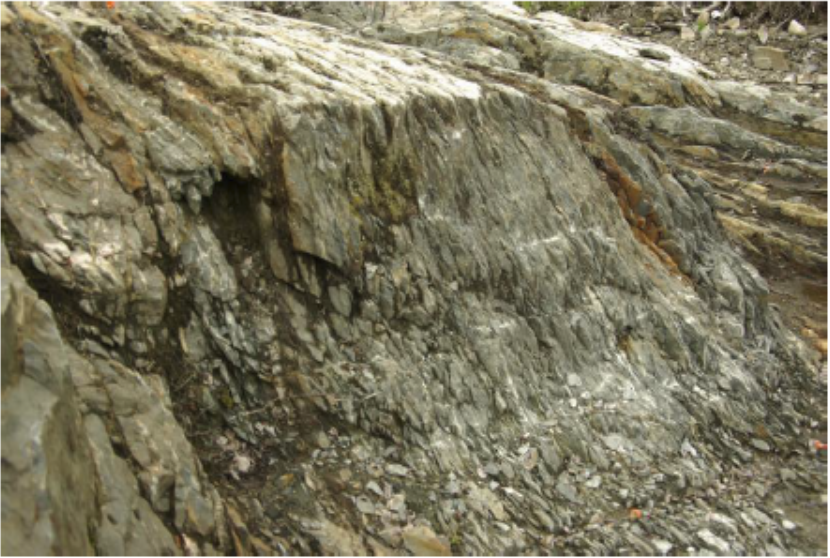
Example of Shear Zone on the East-West Property
Source: 2017 Knick East-West Technical Report
.
Mineralization is often associated with networks of quartz-tourmaline-ankerite veins in competent basalts/andesites associated with less competent sheared and altered ultramafic flows. Mineralization is in the form of free gold, with specks of gold observed in the drill core. Sulphides content is generally low, with pyrite content usually varying from 0 to 5%. Chalcopyrite is rarely observed. No studies have been done to verify whether gold is associated with the sulphides.
The West Zone mineralization is associated with a network of quartz-ankerite-tourmaline veins, locally with sulphides (pyrite and pyrrhotite), in an intermediate to mafic lava, itself included in ultramafic flows. The mineralized envelope of the West Zone strikes 110 degrees. It is parallel to, and probably associated with a component of the Marbenite Fault system. This zone is included in a 200 m x 200 m area bounded by UTM coordinates 279 100E, 279 300E, 5 335 000N and 5 335 200N. This Zone has been explored to a depth of 200 m. Knick drilled 32 holes on the West Zone area, 20 of which have returned gold grades of over 1 g/t Au. The usual gold values intersected on the West Zone are in the order of 2 to 3 g/t Au over true widths of less than 1 m. Historical drilling and the drilling done by Knick seem to have defined this zone well, at least to a vertical depth of 200 m.
The East zone is less well defined, being less drilled. It is made up of quart-carbonate veins, sometimes brecciated, containing an average of 1-5% sulphides, mainly as pyrite and pyrrhotite, and more rarely chalcopyrite. It has been traced over a distance of 400 m in an east-west direction, from UTM coordinates 279 900E to 280 300E at 5 334 950N. Knick drilled 19 holes on the East zone in 2009, another four in 2011, and seven more in 2016-17. Sixteen of these returned values of over 1 g/t Au.
Stripping by Knick has revealed at least three new gold zones: Raven, Gilbert and Grand Canyon. All the stripped areas are located in the eastern part of the Property, close to the East Zone.
EXPLORATION
Up until the end of the 1990s, exploration work was carried out separately on the northern and southern parts of the Property. The southern part of the Property is made up of claims 2415484, 2415485 and 2415486. The northern part is made up of claims 2415483, 2415487, 2415488 and 2415489.
Historic Exploration – Southern Part of Property
The first exploration work carried out on the southern part of the Property dates back to 1937. From this time, until the beginning of the 1970s, little exploration work was reported. Magnetic prospecting was done by Dubuisson Goldfields in 1937, followed by a geological report by Norman Malartic Mines in 1945. During the next 16 years, no exploration was reported.
In 1961 and 1962, two other magnetic surveys were conducted by Ambassador Mining Development and Dubuisson Goldfields. After that, nothing happened until 1970, when a new magnetic survey was reported by Gold Resources. Finally, in 1976, three holes totaling 508 m were drilled by Babylon Minerals, but no significant gold grades were reported.
From 1980 to 1984, the mineral claims were registered in the name of Rénald Garneau. Magnetic and VLF7 surveys were completed at that time, followed by an evaluation report. In 1988, the claims were registered in the name of Black Cliff Mines. Magnetic, VLF and IP surveys were reported, followed by one 68 m drill hole. No significant gold grades were reported. In 1989, the claims were optioned by Malartic Hygrade Gold Mines, and four holes totaling 659 m were drilled. No significant gold grades were reported.
In 1993, the claims appear under the name of Alain Guy Garneau. Nine kilometers of magnetic survey were reported. From 1993 to December 31, 2008, no exploration work was recorded.
Historic Exploration Northern Part of Property
From 1933 to 1940, the northern part of the property was held by West Shore Malartic Gold Mines. Trenches were dug in the eastern part of the Property. A 229 m shear zone striking 070 degrees was discovered, and anomalous gold values were reported.
In 1945-1956, Clarnor Malartic Mines took an option on the claims. Eleven holes were drilled, five of them on part of a stratigraphic section in the eastern part of the Property.
In 1959, the Property was part of a large claim block held by Little Long Lac. A program of geophysical surveys was completed. Holes were drilled on lots 17 and 18, outside the East-West Property. In 1974-1975, the Property was known as the Audet option. Three holes totaling 1,668 feet were drilled by Babylon Minerals, but no significant gold grades were obtained. In 1979, the three claims corresponding to lots 21, 22 and 23, range 10, were known as the Arnold James Property, and in 1980 they were optioned by Auguste Mitto and William Plexman, who sold them to Cache d’Or Resources.
From 1981 to 1987, Cache d’Or Resources completed magnetic and VLF surveys, followed by 184 drill holes totaling approximately 39,600 m. At the beginning of the 1990s, Cache d’Or Resources became Exploration Auriginor Inc.
A historical archive of drilling was assembled by Knick from Assessment Reports on file with the Quebec government. Using this information, Emergent reviewed this data comprising 181 historic drill holes totaling 40,192 m of drilling.
Significant drill intercepts (intercepts greater than 10.0 g/t Au and with lengths greater than 1.0 m) from historic drilling prior to Knick that occurred between 1984 and 1987 include:
- 13.13 g/t Au over 1.83 m from a depth of 140.21 m to 142.04 m in hole CD-19
- 10.73 g/t Au over 1.22 m from a depth of 96.77 m to 97.99 m in hole CD-28
- 134.64 g/t Au over 1.68 m from a depth of 145.08 m to 146.86 m in hole CD-55
- 51.98 g/t Au over 3.20 m from a depth of 125.27 m to 127.47 m in hole CD-78
- 24.75 g/t Au over 1.52 m from a depth of 141.43 m to 142.95 m in hole CD-81
- 64.83 g/t Au over 2.75 m from a depth of 137.92 m to 140.67 m in hole CD-149
- 226.70 g/t Au over 2.24 m from a depth of 199.03 m to 201.17 m in hole CD-156
- 64.36 g/t AU over 1.68 m from a depth of 81.99 m to 83.36 m in hole CD-172
Significant drill intercepts (intercepts greater than 0.5 g/t and lengths greater than 3.0 m) from historic drilling prior to Knick that occurred between 1984 and 1987 include:
- 2.26 g/t Au over 5.49 m from a depth of 89.61 m to 95.10 m in hold CD-84-10
- 4.09 g/t Au over 4.73 m from a depth of 96.01 m to 100.74 m in hold CD-84-10
- 4.14 g/t Au over 3.51 m from a depth of 103.17 m to 106.68 m in hole CD-84-10
- 51.98 g/t Au over 3.20 m from a depth of 125.27 m to 127.47 m in hole CD-78
- 2.11 g/t Au over 3.96 m from a depth of 103.02 m to 106.98 m in hold CD-79
- 1.29 g/t Au over 3.66 m from a depth of 78.94 m to 82.60 m in hole CD-83
- 3.60 g/t Au over 5.49 m from a depth of 210.31 m to 215.80 m in hole CD-92
- 2.79 g/t Au over 7.01 m from a depth of 26.88 m to 43.89 m in hole CD-111
- 1.54 g/t Au over 7.62 m from a depth of 201.32 m to 208.94 m in hole CD-114
- 1.03 g/t Au over 4.58 m from a depth of 70.10 m to 74.68 m in hole CD-145
- 1.20 g/t Au over 3.05 m from a depth of 106.68 m to 109.73 m in hole CD-150
- 3.86 g/t Au over 3.51 m from a depth of 150.72 m to 154.23 m in hole CD-152
- 0.86 g/t Au over 3.04 m from a depth of 159.11 m to 162.15 m in hole CD-161
- 0.69 g/t Au over 6.09 m from a depth of 128.02 to 134.11 m in hole CD-165
- 1.08 g/t Au over 4.12 m from a depth of 208.94 m to 213.06 m in hole CD-169
- 1.38 g/t Au over 3.05 m from a depth of 18.59 m to 21.64 m in hole CD-172
- 1.14 g/t Au over 4.57 from a depth of 32.92 m to 37.49 m in hole CD-173
Drilling indicates the potential for both higher grade intercepts (>10 g/t Au) and lower grade bulk disseminated mineralization (>3 g/t and widths >3 m). Additional information on these significant intercepts is provided below in Table 1. This table includes only drilling intercepts greater that 0.5 g/t gold.
VIEW TABLE 1 HERE
As was often the case for exploration work done prior to 2001, the historical assessment reports provide little or no information on sample preparation, analysis or security. Work was done prior to the implementation of National Instrument 43-101 and CIM standards of disclosure. No core is available for re-assay. As such, the historic information should not be relied upon and is provided for information purposes only. Note that it provides a guide for future exploration. It may be possible to statistically analyze historic data with modern drilling and assaying done to NI 43-101 and CIM standards to validate the historic drilling. However, this analysis had not yet been done.
Historical reports show that almost all the gold assaying reported was done by fire assay. Only a few samples were assayed for copper and silver. It should also be noted that while free gold was observed, there was often no significant gold grade reported in the assays. At the time of the historical drilling, 81 check samples were re-analyzed, which over a total of 5,800 samples represented a verification rate of 1.4%.
A nugget effect is seen locally. In general, check assays showed good correlation, but some samples registered up to 100% variation. As neither the name of the laboratory that did the assays nor the preparation method is indicated in the historical reports, it was impossible to draw conclusions regarding the validity of the results. It appears that no assays were done by metallic sieve, although this is impossible to confirm for sure, which is a method used to assay almost the entire sample when free gold is observed or a strong nugget effect is suspected.
Summary of Drilling Programs by Knick Since 2007
Knick acquired the Property in 2007. They subsequently conducted three drilling programs. The first consisted of 38 holes for a total of 7,228.9 m drilled from July 7 to December 20, 2009, the second totaled 5,635.4 m in 33 holes drilled from February 2, 2011 to April 2, 2011, and the third totaled 6,864 m in 29 holes drilled from October 31, 2016, to March 5, 2017.
Significant drill intercepts (intercepts greater than 10.0 g/t Au and with lengths greater than 1.0 m) from Knick drilling that occurred in 2009, 2011, and 2016/17 include:
- 11.149 g/t Au over 1.95 m from a depth of 52.10 m to 54.05 m in hole LEO-09-21
- 10.080 g/t Au over 1.45 m from a depth of 10.55 m to 12.00 m in hole LEO-09-33
- 31.500 g/t Au over 1.25 m from a depth of 101.95 m to 103.20 m in hole EW-16-06
- 15.191 g/t Au over 2.40 m from a depth of 79.15 m to 81.55 m in hole EW-16-10
- 13.300 g/t Au over 1.10 m from a depth of 260.30 m to 261.40 m in hole EW-17-20
- 10.010 g/t Au over 1.40 m from a depth of 195.20 m to 196.60 m in hole EW-17-27
Total drilling by Knick was 100 drill holes totaling 19,728 m of drilling, as shown in Table 2 below. This table includes only drilling intercepts greater that 0.05 g/t gold.
VIEW TABLE 2 HISTORY HERE
Drilling conducted by Knick was done to meet NI 43-101 Standards for Disclosure and CIM Standards (see below for details). Historic drilling prior to Knick was done before the introduction of NI 43-101 Standards and CIM Standards. The true width of individual intercepts is unknown. Emergent’s geologists have not verified the historic or Knick results.
Knick 2009 Drilling Program
From July 7 to December 20, 2009, Knick drilled 38 holes for a total of 7,228.6 m. Forage G4 of Val-d’Or was the drilling contractor. NQ core size was used. Hole deviation was measured using a Flexit instrument in Phase I and a Reflex instrument in Phase II. In both cases, readings were taken every 3 m. Casings were left in the hole where the overburden was less than 3 m deep, and where the geology was judged favorable for gold mineralization. A total of 16 casings were left in place. Sixteen holes were drilled on the West zone and nine on the East zone, and the remaining holes were drilled to test IP anomalies, geological contacts and extensions of the West and East zones.
Each day, a Knick technician picked up the drill core at the drill site and brought it to Knick core shack, located in the basement of the Knick exploration office in Val-d’Or. Core boxes were then opened and put on racks. The core was logged as soon as possible, sample intervals defined, and sample numbers inserted into the core boxes. The core was photographed before sampling. Then a Knick technician sampled the core. Samples from Holes LEO-09-01 to LEO-09-18 were split using a core splitter, while other holes were sawed using a diamond blade saw. In both cases, one half of the core was kept in the core box as a witness, while the other half was put in a plastic bag with the sample number, and the bag was sealed. This process was repeated for each sample.
After that, the sample bags were grouped by batch of 15 to 20 bags and put into a shipping bag, which was also identified and sealed by the technician. About once a week, these bags were sent to the assay lab. The entire process was under the supervision of Robert Campbell, P.Geo. During sample preparation, blanks and standards were inserted in the analytical chain, as follows: 1 blank and 1 standard for every 25 samples. Blanks were made of decorative white stones, mainly composed of calcite and to a lesser extent quartz, bought in a garden center in Val-d’Or. Of the 83 blanks assayed, only four revealed values slightly over the detection level, with 0.015, 0.006, 0.008, and 0.007 g/t Au. Three standards were used randomly. Each time, 60 grams were submitted for assaying. Standards were provided by Rocklabs.
Assays by fire assay or metallic sieve and the Pt-Pd assays were performed by Lab Expert of Rouyn-Noranda. Lab Expert is a laboratory certified by the “Standard Council of Canada: proficiency testing provider for specific mineral analysis parameters”, and more precisely for analysis of Au, Pt, Pd, Zn, Ni and Co. It is certified ISO 9001:2008, which is a general quality assurance standard. It is not certified ISO/IEC 17025, which is more specific to analytical and calibration laboratories; however, the results obtained from the blanks, standards and check assays revealed the high quality of the assays performed by Lab Expert. No crosschecks were done by another laboratory during the 2009 drilling program.
Once the samples were prepared and analyzed by Lab Expert, a portion of the powders were sent to Actlabs for analysis in accordance with their 1E1 analytical code, whereby 30 elements were analyzed by ICP (inductively coupled plasma). Actlabs is certified ISO/IEC 17025:2005 (CAN-P-4E).
Knick 2011 Drilling Program
From February 2, to April 2, 2011, Knick drilled 33 holes for a total of 5,635.4 m. Forage Performax Inc. of Val-d’Or was the drilling contractor. NQ core size was used. Hole deviation was measured using a Reflex instrument, with readings every 3 m. Casings were left in the hole where overburden was less than 3 m deep and/or where the geology was judged favorable for gold mineralization. A total of 13 casings were left in place.
The sampling method was almost the same in 2011 as it was in 2009, and is summarized below. Samples were cut in half using a diamond blade saw, with one half retained in marked, labelled core boxes as a physical record of each sample section and the other half secured in plastic bags closed with tie wraps, placed in large plastic sacks and sealed again using fiber tape and plastic tie wraps. The samples were transported to Expert Laboratories.
The fire assay/instrumental finish method was used for the gold assays and base metals, along with atomic absorption and/or multi-elements scan, as well as metallic sieve gold analysis as warranted. Gold results were reported in ppb or ppm, depending on the type of assay and the laboratory. Only four samples were also analyzed for Ag and Cu, with results reported in ppm; the four assays revealed very low to background content for Ag and Cu. Various standards and blanks were inserted randomly, and about 5% of the rejects from the core samples were re-analyzed by Agat Laboratories as due diligence. Four standards were used. Each time, 60 grams were submitted for assaying. Standards were provided by Rocklabs.
During the program, 66 blanks were inserted in the analytical chain. Blanks were made of decorative stone mainly composed of calcite and to a lesser extent quartz, bought in a garden center in Val-d’Or. All blanks assayed by Lab Experts returned results under the 5 ppb detection limit. Five blanks were sent to Agat for verification; three returned values under the detection limit, and two returned values of 0.016 and 0.028 ppm Au. As check assays, 122 rejects from the core samples were re-analyzed by Agat Laboratories, corresponding to about 7% of the total number of assays.
Agat is also certified ISO/IEC 17025:2005 (CAN-P-4E).
Knick 2016-17 Drilling Program
From October 31, 2016 to March 5, 2017, Knick drilled 29 holes for a total of 6,864 m. Forage Hébert of Amos was the drilling contractor. NQ core was used, hole deviation was measured using a reflex instrument with readings every 3 m. Casings were left in place where the geology was judged favorable for gold mineralization. A total of 22 casings were left in place.
The drill core from the three drilling programs is stored in part at Knick’s offices and in part at its core shack near the airport in Val d’0r.
The sampling method was the same in 2016-17 as it was in 2011, All samples were cut in half using a diamond blade saw, with one half retained in marked, labelled core boxes as a physical record of each sample section and the other half secured in plastic bags closed with tie wraps, placed in large plastic sacks and sealed again using fiber tape and plastic tie wraps. The samples were transported directly from the core shack to Rouyn-Noranda, when the samples were delivered to the laboratory technicians at Expert Labs, and to Val-d’Or when the samples were sent at ALS Chemex.
The fire assay/instrumental finish method was used for the gold assays and base metals, along with metallic sieve gold analysis as warranted. Gold results were reported in ppb or ppm, depending on the type of assay and the laboratory. Only four samples were also analyzed for base metals, only two revealed anomalous results with 1.48% Zn over 1.31 m from Hole EW-16-15 and 0.88% Cu over 0.75 m from Hole EW-17-27.
Various standards and blanks were inserted randomly, for a total of 190 blanks and 188 standards, or about 8% of the total assays. Six standards were used. Each time, 60 grams were submitted for assaying. Standards were provided by Rocklabs. During the program, 190 blanks were inserted in the analytical chain. Blanks were made of decorative stone mainly composed of calcite and to a lesser extent quartz, bought in a garden center in Val-d’Or.
For the 2016-2017 drilling program, Laboratoire Expert was the main laboratory used, with some samples sent to ALS in Val-d’Or. The analytical protocols used were the same as in 2009 and 2011. ALS Chemex is certified ISO/IEC 17025:2005 (CAN-P-4E).
Knick Geochemistry Work
Trenching, geological mapping, and grab and channel sampling has was done by Knick. Two trenching programs completed in 2009 and 2010 in the east part of the Property close to the East Zone revealed at least three new showings: Raven, Gilbert and Grand Canyon. The main zone is the Raven Zone, which extends more than 200 m in an ENE direction. Gilbert and Grand Canyon Zones are located 125 m and 90 m south of the Raven zone, respectively.
In each trenched area, gold mineralization was found in quartz veins associated with shear zones. On Raven, quartz veins are located on each side of a gabbroic sill in contact with a quartz feldspar porphyry(QFP) to the north and a dacite to the south. On Gilbert and Grand Canyon, the quartz veins are included in intermediate volcanics.
Knick Geophysics Work
On the southern part of the Property, on lot 12 range A Dubuisson, Knick conducted 22.6 km of line cutting, 19 km of magnetic and VLF surveys, and 10.8 km of induced polarization (IP) surveys. In June 2009, the magnetic and VLF-EM surveys were done. The magnetic survey provides information on the magnetic image of the underlying rock formations and contacts between the different geologic units. The VLF-EM survey provides information on several W, NW-E, and SE conduction and resistive zones potentially associated with structural features. The IP survey was conducted between May and June 2009 and defines a wide resistive corridor oriented along and east-west direction and hosing several attractive IP anomalies. In May, 2010, a hole to hole 3D IP survey was conducted identifying eight separate anomalies for follow up.
Emergent Exploration Work
Emergent did not do any exploration work on the property prior to selling it to O3.
TECHNICAL REPORT
A NI 43-101 Technical Report (see link below) was completed on the Property in 2017 by Knick and is available under Knick’s corporate filings at www.sedar.com. Emergent's geologists have not verified the information in this report.
Note that there are currently no mineral resources or reserves yet defined on the Property that meet NI 43-101 Standards for Disclosure or CIM Standards. Additional exploration is needed to develop mineral resources.
Technical Report
QUALIFICATIONS
Mr. Robert Pease, CPG, acting as the Qualified Person for Emgold, has reviewed and approved the information on this webpage.
REFERENCES
NI 43-101 Technical Report Pertaining to the East-West Property, Val d’Or Area, Northwestern Quebec, Abitibi Region NTS 32C04, Prepared for Knick Exploration Inc. by Donald Theberge, P. Eng. M.B.A., November 21, 2017.
NI 43-101 Technical Report and Mineral Resource Estimate for the Kiena Mine Complex, Quebec, Prepared for Wesdome Gold Mines Limited, by C. Beausoleil, P. Geo., Stephane Faure, P. Geo., Guillaume Noel, P.Eng., and Carl Pelletier P. Geo., effective date Dec. 12, 2019, signature date January 25, 2019.
Updated Mineral Resource Technical Report, Marban Block Property, Quebec, on behalf of Osisko Mining Inc., by Elsear Belzile, ING., report date July 29, 2019, effective date June 13, 2016.
DISCLAIMER
Readers are cautioned to review the Disclaimer Page on this website for qualifications that may be applicable to the information contained on this Property Page, including forward looking statements, definitions of mineral resources and reserves, etc. Readers are also cautions to review Emergent's financial statements and management’s discussion and analysis available on this website or at www.sedar.com for additional information.
